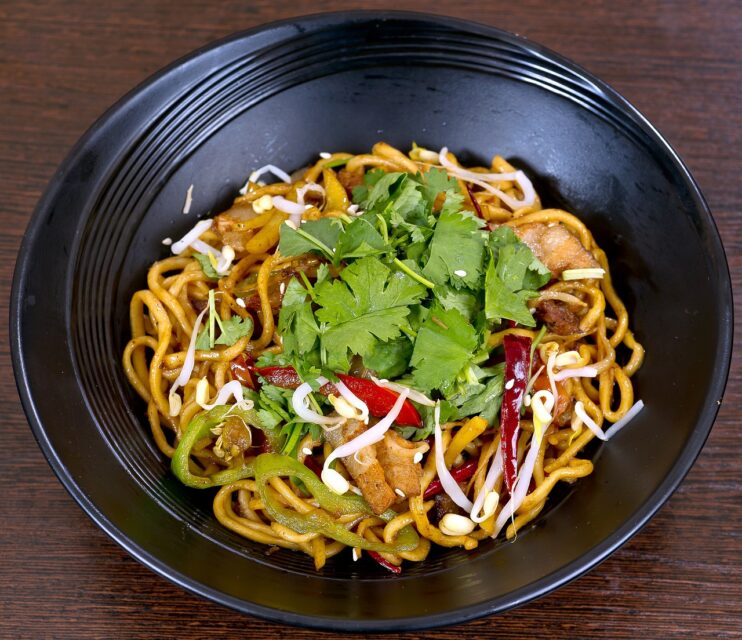Yaki Udon is a simple one-pan dish packed with vegetables, mushrooms and your choice of protein, all coated in an amazingly fragrant sauce that will leave you demanding more.
This recipe uses simple ingredients to prepare the greatest stir-fried udon noodles in just 15 minutes!
Easy 15-Minute Stirred Fried Udon
Stir fried udon is one of my favorite weeknight meals because of its simplicity and delicious flavor.
Japanese udon noodles are my preferred choice for a quick stir fry due to their thick, chewy texture, which allows them to absorb all of the sauce’s aromas.
What is yaki udon?
Yaki Udon (焼きうどん) is Japanese stir-fried udon noodles with pork or seafood and vegetables, seasoned with a sweet and savory sauce.
This is a variant of the popular Japanese stir-fried noodle dish, Yakisoba (焼きそば). Yaki udon, like yakisoba, is a staple of Japanese summer festivals.
It reminds me of eager cooks at the yatai (a mobile street food stand) with metal spatulas in their hands, working quickly with a massive mound of thick, fat noodles on a flat-top grill. The steam floating through the air and the inviting perfume draw you in.
Yaki udon noodles are extremely famous in Japan and can be seen at festivals (omatsuri) and Izakayas (Japanese pubs) all over the world, with shrimp or chicken Yaki udon being the most common versions.
Yaki udon is also enjoyed at home in many Asian households, with variations based on the ingredients available. Because of its diverse flavors, it’s also an excellent dish for cleaning out your refrigerator and using up leftover ingredients to produce a tasty stir-fried udon.
If you have any kewpie mayo and bonito flakes on hand, I highly recommend using these as garnishes to maximize the umami flavor. It’s very delicious!
What is the difference between yaki udon and yakisoba?
Yaki Udon always includes udon noodles. Udon noodles are thick, chewy white noodles produced from wheat flour and water.
Udon noodles are quite adaptable; they can be used in hot noodle soups like Kitsune Udon and Nabeyaki Udon, cold noodle meals like Tanuki Udon, and stir-fried dishes like yaki udon.
Yakisoba is created with chukamen (中華麺), yellowish Chinese-style noodles made from wheat flour and kansui (alkaline solution). The same noodles are used in Ramen and Yakisoba.
Instructions for making yaki udon and required ingredients
This very comfortable stir-fry noodle can be made with almost any protein and vegetables from your refrigerator!
Protein: Traditional yaki udon is typically made with pork. You can use a thinly sliced pork belly to add more flavor.
However, you may always use chicken, beef or seafood like shrimp and squid. For vegetarian choices, simply cut out the beef or substitute thinly sliced fried tofu (or tofu puffs).
- Vegetables: Use vegetable scraps from your refrigerator. Have any mushrooms on hand? Add them in!
- Udon Noodles: Yaki udon can be made with frozen, fresh or dried noodles. I recommend using fresh or frozen udon noodles for the greatest texture. Continue reading below.
- Sauce: For this dish, I’ll provide two possibilities. Both taste identical but are made with different condiments.
- Optional toppings: For added flavor, I like to top the noodles with katsuobushi (shaved bonito flakes) and beni shoga (red pickled ginger). You can find them in Asian grocery stores.
What do I need to make Yaki Udon?
The nicest aspect about this dish is that it only requires a few materials from your kitchen to prepare and the combination of vegetables and meat can be easily changed to your liking.
This recipe requires the following ingredients:
- Udon noodles: For this dish, I like frozen “Sanuki-style” udon noodles because they are easily accessible, can be stored in the freezer for months, and are the ideal sort of udon to use in a stir fry.
Frozen udon noodles have a lovely chewy feel and are less likely to get mushy or overcooked during the cooking process.
- Shrimp or chicken: or your choice of protein, such as thinly sliced beef, hog, bacon, or other seafood.
Tofu and mushrooms are two vegetarian possibilities, but you may also add additional veggies like bell pepper or bok choy.
- For aromatics, use onion and garlic. To add to the stir fry, combine cabbage, carrot, mushrooms, and green onions. Feel free to get creative with this! Stir-fry is an excellent way to use up leftover vegetables from your refrigerator.
- To make the sauce, combine dark soy sauce, oyster sauce, mirin, and brown sugar. If you prefer a little spiciness, you can add some Gochugaru or crushed red pepper to the sauce.
Kewpie mayo, bonito flakes, toasted sesame seeds and/or green onions are optional garnishes.
Tips & tricks to make the best Yaki Udon Noodles
Although this Yaki udon recipe is simple to follow, I wanted to provide a few pointers to help with the cooking process. Here are some recommendations for the greatest udon stir fry:
1. Prepare your ingredients in advance, including the sauce
Stir fry recipes come together quickly in a hot pan, and prepping all of the ingredients ahead of time will greatly simplify the procedure!
2. Use hot water to quickly thaw your frozen noodles
To defrost frozen noodles quickly, immerse them in hot water for approximately a minute before delicately loosening them with chopsticks.
When the noodles are loose, strain and rinse them in a colander with cold water to keep the texture, then set aside for the stir-fry.
You can alternatively cook them in boiling water, but I found that this method is much more convenient and time-efficient.
3. A wok can help you cook more efficiently
This is essential cookware for any stir-fry dish, including the Yaki udon recipe. A wok conducts heat fast and evenly across its entire surface, and the curvature allows food to be thrown without making a mess.
Using a wok will also aid in caramelizing the noodles, as the high heat produces a great burnt flavor as the sauce hits the pan.
So there you have it! Making your udon stir fry at home is quite simple, as long as you follow the proper instructions.
As previously said, this stir-fried dish is cooked in a single wok or large pan, making cleanup a joy! Let’s be honest: we all could use fewer dishes to clean, and easy meals like these are a breath of fresh air.
Yaki Udon Cooking Tips
Yaki Udon is a quick and easy home-cooked meal that you may prepare for your family or yourself. You’ll just need common ingredients, which you most likely already have in your refrigerator.
Tip #1: Store udon noodles in your pantry
Always keep frozen or dried udon noodle packages in your pantry. Instead of ordering takeout or eating out, you may cook tasty but simple udon noodle dishes at home. My daughter likes udon noodles, so I always have some in the freezer for a quick supper.
Tip #2: Do not overcook the udon noodles
Because you will be cooking the udon alongside the other ingredients in the frying pan, you do not need to cook the noodles until they are soft. Overcooking will only impact the final texture.
Tip #3: Cover and steam your vegetables
Instead of constantly stir-frying, cover the frying pan and steam the vegetables. Make careful to set the stove’s heat to low. With the moisture in the vegetables, all of the bulkier veggies will steam and become soft quickly.
If you don’t have a lid for your frying pan, you can still stir-cook the ingredients.
Tip #4: Use a pair of tongs
If you don’t already have one in your kitchen, grab this pair. You will not be disappointed with your purchase. Mixing the noodles and other ingredients using tongs is considerably easier than using chopsticks or a spatula or two. You can trust me on this!
Tip #5: Use a big frying pan
Finally, I suggest using the largest frying pan you own. Stir-frying requires more surface area, and taller sides help keep the food in the pan.




